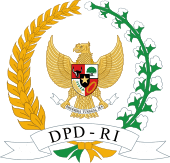Regional Representative Council
| Regional Representative Council Dewan Perwakilan Daerah | |
|---|---|
 | |
| Type | |
| Type | |
Term limits | None |
| Leadership | |
Speaker |
Mohammad Saleh Since October 5, 2016 |
Deputy Speaker |
Farouk Muhammad Since October 2, 2014 |
Deputy Speaker |
GKR Hemas Since October 5, 2016 |
| Structure | |
| Seats | 136 (4 vacant) |
 | |
Political groups |
Vacant: 4 seats |
| Authority |
On the area of regional governments only:
|
| Elections | |
| Single non-transferable vote | |
Last election | 9 April 2014 |
| Meeting place | |
|
Legislative Complex Jakarta Indonesia | |
| Website | |
|
www | |
 |
| This article is part of a series on the politics and government of Indonesia |
| Pancasila (national philosophy) |
| Constitution |
|
Executive |
| Foreign relations |
The Regional Representative Council (Indonesian: Dewan Perwakilan Daerah, DPD), alternatively translatable as the House of Regions or as the House of Regional Representatives, is one of two parliamentary chambers in Indonesia. Together with the Dewan Perwakilan Rakyat, (DPR), it makes up the Indonesian national legislative body, the Majelis Permusyawaratan Rakyat (MPR).[3] Under Indonesia's constitution, the authority of the DPD is limited to areas related to regional governments and can only propose and give advise on bills to the DPR.[1] Unlike the DPR, the DPD has no direct law-making power.[2]
History
The DPD was created by the third amendment to the 1945 Constitution of Indonesia enacted 9 November 2001 in a move towards bicameralism. The DPD does not have the revising powers of an upper house like the United States Senate. Article 22D restricts the DPD to dealing with bills on "regional autonomy, the relationship of central and local government, formation, expansion and merger of regions, management of natural resources and other economic resources, and Bills related to the financial balance between the centre and the regions."[4][5]
The International Foundation for Electoral Systems conducted a tracking survey in the Indonesian legislative elections in 2004 which showed that not all voters knew how to vote for candidates for the new Regional Representative Council, or were even aware of its existence.[6]
The power of the DPD is relatively weak compared to the older chamber, the DPR, notably it has no direct law-making or the power to veto bills.[7] According to Indonesian constitutional scholar Jimly Asshiddiqie, the relative weakness of the DPD was a result of a compromise in the committee responsible for the constitutional amendment.[7] The reformist faction wanted a strong second chamber in addition to the existing DPR in order to strengthen checks and balances, but this was opposed by the conservative faction.[7]
Membership
Article 22C of the Constitution rules that all members of the DPD are elected through the same Legislative Election every five years, along with the members of DPR. The total number of members is limited so that it does not exceed one third of that of DPR. Each of the 34 provinces of Indonesia elects 4 members to the DPD on a non-partisan basis, although many candidates in the April 2004 election had links to the parties represented in the People's Representative Council, the Dewan Perwakilan Rakyat or DPR.
Powers and structure
The DPD can propose such bills to the DPR and must be heard on any regional bill proposed by DPR. A third legislative body, the People's Consultative Assembly (Indonesian: Majelis Permusyawaratan Rakyat) (MPR), comprises the members of the DPR and the DPD.
Miscellaneous
The acronym DPD is a common one in Indonesia. In political parties, it usually stands for Indonesian: ''Dewan Pimpinan Daerah'' (Regional Leadership Council) and seated at each provincial capital. It should not be confused with the Legislative body.
References
- Denny Indrayana (2008) Indonesian Constitutional Reform 1999-2002: An Evaluation of Constitution-Making in Transition, Kompas Book Publishing, Jakarta ISBN 978-979-709-394-5
- Asshiddiqie, Jimly (2009). "Lembaga Perwakilan dan Permusyawaratan Rakyat Tingkat Pusat". jimly.com (in Indonesian).
Notes
- 1 2 Asshiddiqie 2009, pp. 11-12.
- 1 2 Asshiddiqie 2009, p. 12.
- ↑ Denny Indrayana (2008), p369
- ↑ Denny Indrayana (2008), p446
- ↑ Law No. 20/2008 on Elections
- ↑ na Thalang, Chanintira (June 2005). "The Legislative Elections in Indonesia, April 2004". Electoral Studies. 24 (2): 326–332. doi:10.1016/j.electstud.2004.10.006.
- 1 2 3 Asshiddiqie 2009, p. 11.
External links
- DPD homepage (Indonesian)